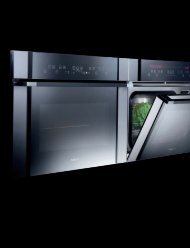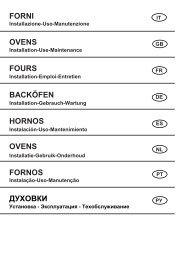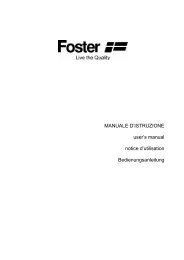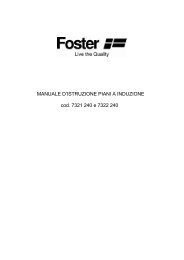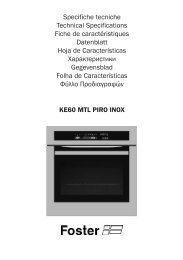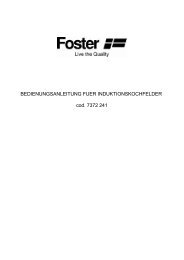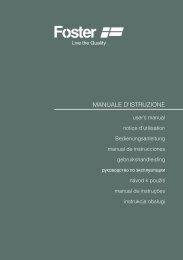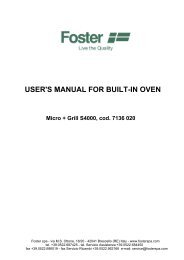Instruction manual - Foster
Instruction manual - Foster
Instruction manual - Foster
Create successful ePaper yourself
Turn your PDF publications into a flip-book with our unique Google optimized e-Paper software.
INSTRUCTIONS FOR INSTALLATION AND MAINTENANCE<br />
Stainless steel sinks<br />
<strong>Foster</strong> spa<br />
via M.S. Ottone, 18/20<br />
42041 Brescello (RE) - Italy<br />
tel. +39.0522.687425 - tel. Servizio Assistenza +39.0522.684450<br />
fax +39.0522.686019 - fax Servizio Ricambi +39.0522.962166<br />
e-mail: service@fosterspa.com<br />
www.fosterspa.com
Istructions for the installation,<br />
use and maintenance of<br />
kitchen stainless steel sinks<br />
Sinks’ material: austenitic stainless steel AISI 304 - 18/10<br />
UNI EN 13310:2004<br />
(kitchen sinks for domestic use, functional features and tests’ methods)<br />
INSTALLATION<br />
Standard and flat (3 mm bended) edge<br />
Before making any cut-out on the worktop, we suggest to verify and lay the sink on the<br />
worktop itself and/or on the cabinets in order to verify that the external dimensions of the<br />
bowls are compatible with the cabinets themselves, in order to avoid making cut-outs for<br />
sinks that cannot be installed.<br />
We also recommend to verify the possibility to install taps and other accessories, by<br />
checking the place they need and the place that remains. Also verify the possibility to<br />
accede to the water main tap under the sink, and that the positioning of the siphon is<br />
feasible. To install the sink, one must make a cut-out on the worktop according to the<br />
template included in the packing.<br />
Once the cut-out is made, one must position the gasket around the perimeter of the<br />
hole. Before installing the sink, please position the waste-fitting and overflow pipe (when<br />
present); when available, also the command of the autiomatic waste-fitting must be<br />
installed at this stage. Make<br />
sure that the external edge<br />
of the sink is positioned<br />
upon the gasket, so as to<br />
create a barrier preventing<br />
the infiltration of water<br />
and dirt between sink and<br />
worktop.
After having positioned the sink on the worktop, fix it by tightening the screws of<br />
the brackets which are provided (the screws must be tightened just enough to have<br />
the brackets clamp down on the worktop).<br />
Afterwards, remove the excess gasket with a<br />
cutter. The taps can be installed before or after<br />
the positioning of the sink.<br />
After having installed the sink, connect the<br />
waste-fitting with the siphon. Check the watertightness<br />
by closing the basket of the wastefitting,<br />
open the tap and wait until the water<br />
level reaches the overflow; shut the tap, and<br />
wait several minutes, verifying that the water<br />
does not drain away. Empty the sink.<br />
Flush-mount edge<br />
For a correct installation of the flush-mount sinks, please follow strictly the technical<br />
sheet (template) provided with the sink; only qualified personnel should make the cutout,<br />
and a computer-operated machine is necessary. It is advisable to accurately clean<br />
the seat for the cut-out, and to insert the gasket which is provided, between the sink and<br />
the worktop, so as to avoid possible water infiltration into the worktop or the cabinets.<br />
The work must be carried out by experienced personnel.<br />
Do not use electric screwdrivers to tighten the brackets.<br />
The tightening torque must not exceed 60 N/cm.<br />
It is advisable to install the flush-mount sinks on hydro<br />
repellent materials, in order to avoid eventual deformations<br />
of the material itself.
Undermount installation<br />
For the undermount sinks, proceed as for the normal built-in sinks.<br />
Make a cut-out on the worktop following the template and/or instructions provided with<br />
the sink. Before installing the sink, seal with silicone. Tighten the brackets.<br />
20<br />
37<br />
Fixing bracket for<br />
undermount sinks<br />
xed bracket<br />
sliding bracket<br />
Fixing bracket<br />
system<br />
Fixing system<br />
FR FI<br />
xed bracket<br />
S<br />
xed bracket<br />
FI<br />
lateral section
CARE and MAINTENANCE<br />
The <strong>Foster</strong> collections are the result of a huge experience, and a careful development<br />
to meet at best the necessities of the users’, so as to obtain a high-quality product. It is<br />
important, however, to inform our customers that one must also use the product correctly<br />
and maintain it properly.<br />
As all materials, also stainless steel can become dirty; by following very simple<br />
instructions, one can bring the sink back to its original shine.<br />
For everyday’s maintenance, wash the sink with water and soap, or a product to wash<br />
the dishes, rinse abundantly, and do not forget to dry. For more obstinate dirt, the STEEL<br />
CLEAN line of products, proposed by <strong>Foster</strong> and available at all our Assistance Centres<br />
throughout the Country, is very suitable to eliminate it without much fuss. Take care<br />
to avoid shocks, to drop heavy objects on the sink, and not to use utensils which can<br />
scratch the surface. Also avoid the contact with chemicals, cleaners for metal, products<br />
to take off paint, metal brushes. Do not leave for long stretches of time tomato residues<br />
on the sink, as well as milk, and coffee on the sink; also, avoid long contacts with metal<br />
drums with wet bottoms, and iron objects in general. Please note that the long contact of<br />
any of the above-mentioned substances with the sink can originate a corrosive attack of<br />
electrochemical nature, even though very mild.<br />
ATTENTION<br />
• Rinse accurately after use, and dry with a clean cloth<br />
• To clean the sink, normal detergent can be used, as long as not containing hydrochloric Acid<br />
(commercial Muriatic acid) or its derivates<br />
• In case of persistant staine, try to clean with some warm vinegar or with specific products for<br />
Stainless steel (the specific line of products “<strong>Foster</strong> Steel clean” is suggested)<br />
• Do not use steel sponges to clean the sink, or any other item that could scratch the surface<br />
• Avoid using muriatic acid or bleach<br />
• Do not leave iron objects on the sink for long<br />
• Please keep this instructions leaflet<br />
<br />
via M.S. Ottone, n. 18/20 - 42041 Brescello (RE) - Italia




